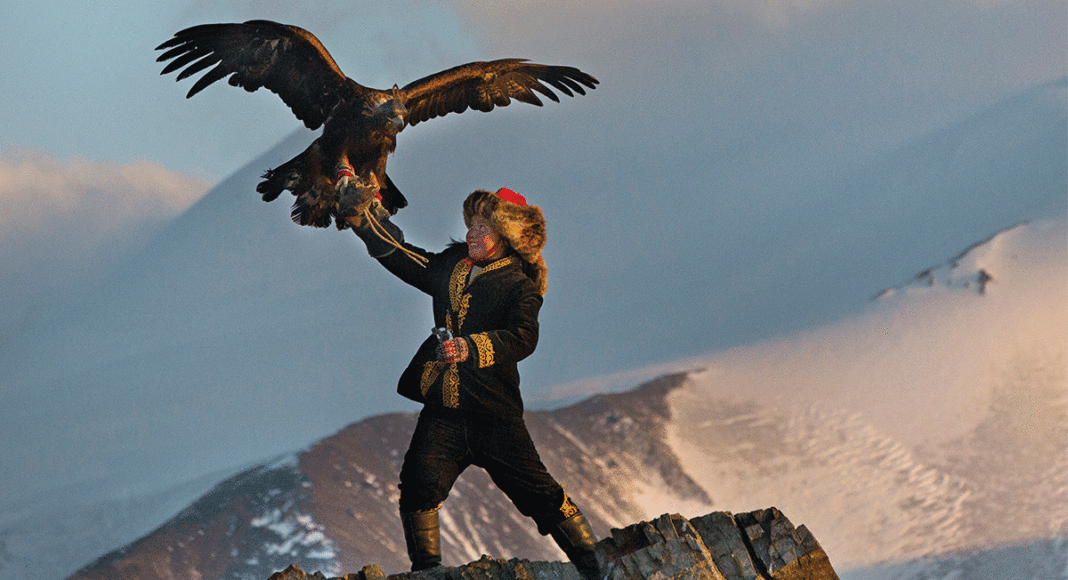The best girl-power stories are true. Fiction can inspire, but what better validation can there be for girls in the audience than a young woman who beats the odds in real life to excel at some traditionally male-dominated activity that she loves? Someone like Aisholpan Nurgaiv, the 13-year-old heroine of the stunningly beautiful documentary The Eagle Huntress, a daughter of Mongolian nomads who defies tradition to master the ancient art of hunting with eagles.
Directed by first-timer Otto Bell, the film was shot by Simon Niblett, with great sensitivity to the severe beauty of the vast, craggy steppes of the Kazakh region of Mongolia, and for the folkways of its people. Nomadic families move out into the grasslands with their yurts to graze their sheep during the warm weather, but band together in their village of stone bunkers when winter comes.
Aisholpan’s father is distinguished among the villagers as an eagle hunter, a skill learned from his own father. Indeed, the men in their family have been eagle hunters for 12 generations. Anyone bred into the brotherhood learns to capture his own baby eaglet from an unattended nest, bond with the bird he trains to respond to his commands, and hunt the small game the nomads need to provide fur lining for their winter clothes. At the end of seven years of service, the hunter returns his bird to the wild with a ceremony of thanks.
It’s always been a skill handed down from father to son, but Aisholpan has been fascinated by her father’s birds from a very young age. He’s taught her to feed and handle the bird, and to wear the forearm cuff on which the eagle perches. Eagle hunting is “a calling,” he says. “It has to be in your blood.” So when his daughter wants to train to be an eagle hunter, he encourages her—and the filmmakers are there every step of the way.
Her father takes Aisholpan out into the mountains where she must “earn an eagle of her own,” by scrambling down a cliff to snatch a female eaglet out of a nest. (Including some amazing up-close footage from a body cam Aisholpan is wearing.) We see her feeding and cuddling with her eagle (a juvenile, yes, but still an enormous bird), and teaching her bird to respond to her particular voice commands. Aisholpan is the youngest and the first-ever female to compete at a festival for eagle hunters from around the region. But the real test comes when she and her father take their shaggy ponies and their birds out into the mountains in deep winter to hunt for real.
It feels a little stagey that the filmmakers set up a chorus of male tribal elders to ask their opinion of a mere girl hunting with an eagle, but their responses (and especially their expressions) are priceless. In contrast to their stoicism is Aisholpan herself, sturdy, rosy-cheeked, quick to laugh, and incredibly poised, either at her chores, or in the traditional fur hat and embroidered regalia of the eagle hunters. Her mother doesn’t mind that Aisholpan “takes after her father more than me.” She tells us, “I just want my daughter to love her life.”
The details we glimpse of that life are impressive. Eagle hunters are held in such esteem, they rarely appear in public without their birds on their arms. When they ride their horses, a ceremonial post is attached to the saddle to provide a rest to hold their arms horizontal so their birds can perch. Each hunter’s rapport with his or her individual eagle is very stirring.
According to a recent interview with Aisholpan, the movie came about after Niblett heard about an eagle hunter teaching his craft to his daughter and took a series of still photographs of them. Director Bell signed on, with Niblett as cinematographer, and when they showed their footage to Star Wars franchise heroine Daisy Ridley, she begged to be involved, as both narrator and co-producer. Aisholpan’s story in this soaring film inspires that kind of devotion.
THE EAGLE HUNTRESS
**** (out of four)
With Aisholpan Nurgaiv A film by Otto Bell. A Sony Pictures Classic release. Rated G. 87 minutes. In Kazakh with English subtitles.












